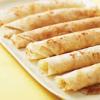I had a torta de carne asada with yucca frita and the husband had a grilled steak sandwich with (yucca) fries. He's not aware he had anything Latin American, and I got to have what I wanted, so everyone is happy. What could be better? ![]()
I sliced the leftover porterhouse very thinly. Most of it was the strip side, and there was little waste because it had already been very aggressively trimmed by the butcher. There was only a very thin 3" long and 1/4" thick piece of bone that made the downward stroke of the T. It wasn't even connected to the top bone. These bones were frozen for stock. I piled the steak on a couple of buns made from split pieces cut from a purchased loaf of French bread. On the other side of the bread, I laid out slices of Muenster cheese. While the yucca fries were roasting in the oven, I sauteed white onion and green bell pepper in a little butter, seasoned with Goya Adobo and black pepper. After the pan of yucca fries was done, I popped the laid out sandwiches into the oven for long enough to melt the cheese. Then I topped the meat side with the onions and peppers and the cheese side with lettuce and thin sliced tomato.
This is the first time I've worked with yucca and the second time I have eaten it. It was a learning experience, with a very promising first result, although, I won't claim my rendition was as good as the ones I ate at Alpaca Peruvian Charcoal Chicken, which were the inspiration for my wanting to venture here at all.
I bought a 2-1/4 pound root from Costa Rica at the local Food Lion. It was the largest they had and I figured it would entail much less waste than the much smaller ones on offer. They are intimidating, and do not look like food, really. There's a barky-looking skin and it seems to be covered by a waxy substance which I wasn't able to determine in my research if that is natural or added by man as preservative. If you are interested at all, don't let the appearance daunt you. I was able to make short work of the waxy bark with just a vegetable peeler. I also made all the cuts on the root with my trusty boning/fillet knife, which I was unsure would be possible.
I searched eG first to see what I could find on this new to me ingredient, but the only mentions here seem to involve ordering it out at restaurants. So I went out on the wild, wild web to see what I could find out about this vegetal beast I was determined to turn into something delicious. Guy Fieri had the simplest and seemingly most popular recipe on the Food Network site. It popped up first. He said just cut it up and put them in hot oil like potatoes. Mr. Fieri does not enjoy much popularity with me, so I decided to hunt further. Serious Eats had a Kenji recipe that insists they must be parboiled first. Further research all indicated parboiling, and this included Cuban, Brazillian and many other sites. A few places said that good yucca frita could be produced by parboiling and then oven roasting at high heat, and I decided to go that way.
I think I may have over cooked my yucca during the boiling step a tad. Sites recommended between 15 and 20 minutes, so I went with 15. It was soft and a bit flaky, and I knew if I tried to shake it with oil in a produce bag, as I had planned, I would damage the planks. So I poured oil onto a baking sheet and flipped the planks around on there to coat and put in a 450 F oven for 30 minutes, turning once. Several sites said you must work quickly with yucca because it discolors when exposed to air. One site said you could refrigerate your parboiled yucca up to 3 days. I had more than I knew we could eat, so I have the excess in the fridge for later. My yucca frita was very good, and we scarfed down all but two of the planks for dinner. The leftover two will go with my husband for lunch tomorrow and he got about half of each of our sandwiches too.
That Porterhouse will have made 6 good meals in all, so it wasn't as expensive as I originally thought.
Oh, more notes on yucca. Several sites mentioned that there is a central woody string-like structure running down the center of the root. I found maybe a 2-1/2" string that looked like the photos on one site in the whole root that was over a foot long. I also found a woody structure shaped like an olive pit, you know, pointed on both ends and fatter in the middle, and rounded. It was about three or so inches long, and 3/4" diameter at its widest point. I don't know if it's because I chose such a large root or it was a mutant. Interestingly, Kenji, who is usually very thorough, had nothing to say on the fibers or woody structures in yucca.
Edit: I just now realized that yucca is the source of tapioca pudding. I truly despise that nasty excuse for an edible dish. Don't let that put you off either. Yucca frita is better than french fries when made well. How could anything be better than french fries, you wonder?
Yucca frita is. Really!




